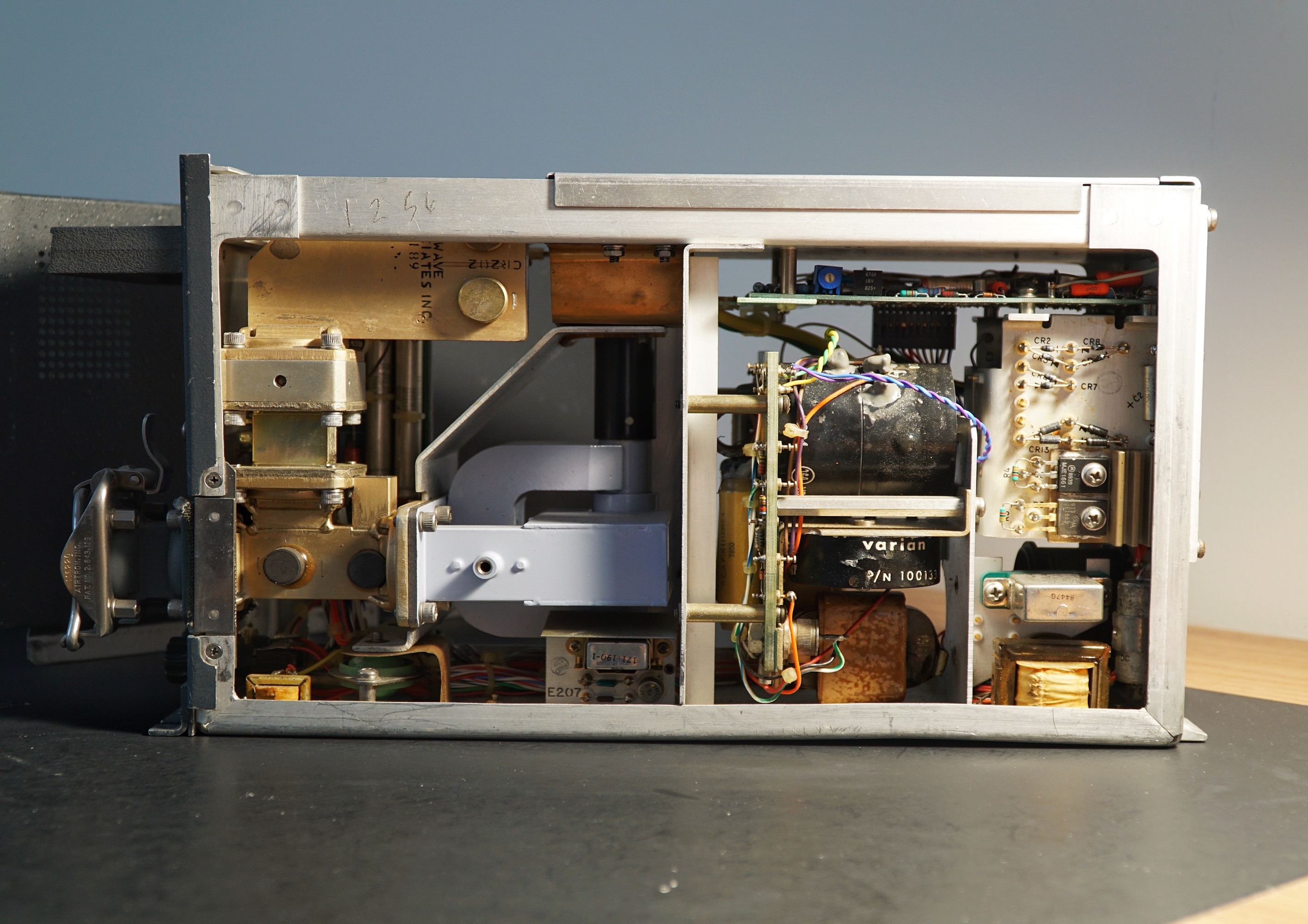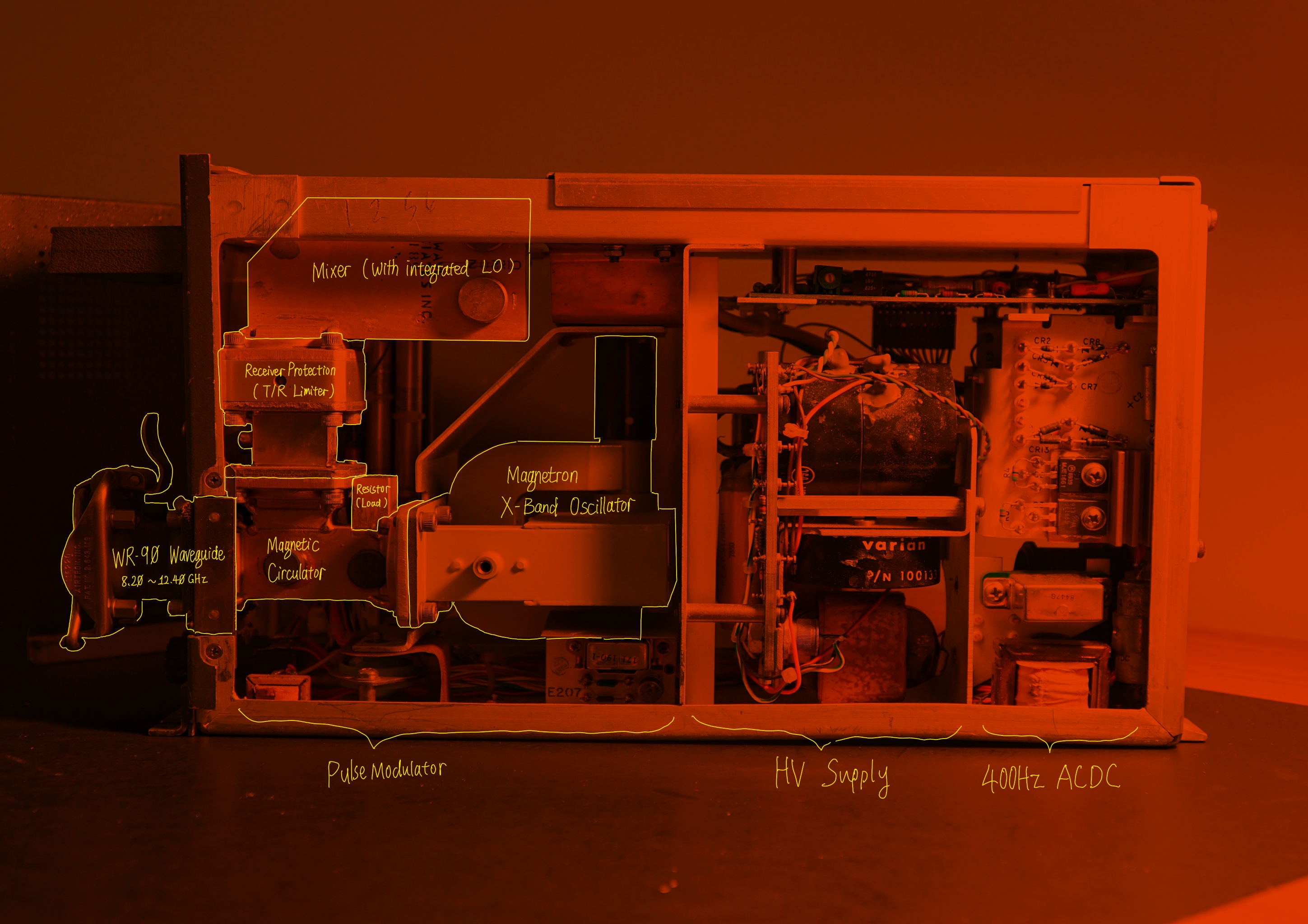RCA/Sperry/Honeywell RT-3001 X-band Pulsed Doppler Radar Transceiver Teardown - 1
written by
Yukiko
on 2022-02-11
Introduction
Recently I bought an Sperry RT-3001 Radar Transceiver on eBay. It is the core part of the
Primus 300 Series digital weather radar system built for small aircrafts. I'm not sure about the age of this module, judging from the labels, my unit is built in 1981. Some information online indicates that this series is relased in 1975. Being a pulsed doppler radar (I will comeback to this), the output pulse power can be as high as 8kW, which is subpar for vacuum tube technology, but definitely unimaginable for us CMOS designers.
Unfortunately, as it normally is for most avionics gears, the sellers online are charging unreasonable prices for the manual of this module. One seller released a number of important pictures on the product page. I have cached all the images.
P1 - 90deg Twisted Waveguide
P2 - System Installation Diagram
P3 - Pinout of the Connectors
P4 - RT-3001 TRX Module Drawings
P5 - Display Unit Drawings
P6 - Display Unit Drawings
P7 - Display Unit Drawings
P8 - System Block Diagram
P9 - Some Screenshots
The most important one is the following:
 System Block Diagram
System Block Diagram
It tells us the internal construction of the TRX module. We start from the Magnitron: It's the same element as the one find in your microwave oven. An intricately designed piece of metal cavity is placed in a magnetic field, when very high voltage is applied (5kV), a high power microwave radiation is created. The frequency of this radiation is defined by the exact shape of that cavity. By switching the power on and off, a microwave pulse is created.
 Some Operation Waveform
Some Operation Waveform
The waveform bounced back contains many information about the target: the amplitude is usually meaning less as it's highly sensitive to subtle changes; the frequency is shifted due to doppler effect, this can tell us the movement of an object, or the movement of ourselves (assuming the target is stationary); the time from wave transmitted to received tells us the distance.
The receiver of this module uses a incoherent architecture: The returned signal is extracted by a circulator followed by a unidirectional isolator. The local oscillator used for down mixing is supplied separately. This is of course a very limited architecture due to its incoherent nature. But it's the only choice due to the poor on/off ratio of TRX switches. Compared to the return signal, the TX signal is extremely powerful, any leakage in the TRX switch can led to destruction of the receiver.
It also suffers from a limitation stemed from the same principle that led to derivation of Heisenberg's uncertainty principle: two variables that happens to be a fourier transform pair can't be measured accurately at the same time. A trade off always exists between Doppler accuracy and timing accuracy.
The To those who have taken a ride on the latest high-end automobiles, you will know that modern cars are equipped with FMCW radars for siutational awareness. Compared to this uncorrelated pulsed doppler, FMCW is a more advanced scheme and have addressed most of the limitations, but much less powerful in terms of the power transmitted.
Teardown
TBD...
The front panel says "Danger Radiation Hazard". Of course this is not a highly harmful ionizing radiation like gamma ray, so fiddling around with it without powering-on should be quite safe.
But be aware, visitors, some vintage aircraft panel displays are painted with radioactive paints to make them glow in the dark, this is indeed a health hazard. Also, in many high power vacuum tubes or integrated circuits, there are components made of Beryllium Oxide, a type of ceramic that provides good thermal performance. This substance is highly toxic.
 Front
Front
 Internal
Internal
 Internal (Annotated)
Internal (Annotated)


 System Block Diagram
It tells us the internal construction of the TRX module. We start from the Magnitron: It's the same element as the one find in your microwave oven. An intricately designed piece of metal cavity is placed in a magnetic field, when very high voltage is applied (5kV), a high power microwave radiation is created. The frequency of this radiation is defined by the exact shape of that cavity. By switching the power on and off, a microwave pulse is created.
System Block Diagram
It tells us the internal construction of the TRX module. We start from the Magnitron: It's the same element as the one find in your microwave oven. An intricately designed piece of metal cavity is placed in a magnetic field, when very high voltage is applied (5kV), a high power microwave radiation is created. The frequency of this radiation is defined by the exact shape of that cavity. By switching the power on and off, a microwave pulse is created.
 Some Operation Waveform
The waveform bounced back contains many information about the target: the amplitude is usually meaning less as it's highly sensitive to subtle changes; the frequency is shifted due to doppler effect, this can tell us the movement of an object, or the movement of ourselves (assuming the target is stationary); the time from wave transmitted to received tells us the distance.
The receiver of this module uses a incoherent architecture: The returned signal is extracted by a circulator followed by a unidirectional isolator. The local oscillator used for down mixing is supplied separately. This is of course a very limited architecture due to its incoherent nature. But it's the only choice due to the poor on/off ratio of TRX switches. Compared to the return signal, the TX signal is extremely powerful, any leakage in the TRX switch can led to destruction of the receiver.
It also suffers from a limitation stemed from the same principle that led to derivation of Heisenberg's uncertainty principle: two variables that happens to be a fourier transform pair can't be measured accurately at the same time. A trade off always exists between Doppler accuracy and timing accuracy.
The To those who have taken a ride on the latest high-end automobiles, you will know that modern cars are equipped with FMCW radars for siutational awareness. Compared to this uncorrelated pulsed doppler, FMCW is a more advanced scheme and have addressed most of the limitations, but much less powerful in terms of the power transmitted.
Some Operation Waveform
The waveform bounced back contains many information about the target: the amplitude is usually meaning less as it's highly sensitive to subtle changes; the frequency is shifted due to doppler effect, this can tell us the movement of an object, or the movement of ourselves (assuming the target is stationary); the time from wave transmitted to received tells us the distance.
The receiver of this module uses a incoherent architecture: The returned signal is extracted by a circulator followed by a unidirectional isolator. The local oscillator used for down mixing is supplied separately. This is of course a very limited architecture due to its incoherent nature. But it's the only choice due to the poor on/off ratio of TRX switches. Compared to the return signal, the TX signal is extremely powerful, any leakage in the TRX switch can led to destruction of the receiver.
It also suffers from a limitation stemed from the same principle that led to derivation of Heisenberg's uncertainty principle: two variables that happens to be a fourier transform pair can't be measured accurately at the same time. A trade off always exists between Doppler accuracy and timing accuracy.
The To those who have taken a ride on the latest high-end automobiles, you will know that modern cars are equipped with FMCW radars for siutational awareness. Compared to this uncorrelated pulsed doppler, FMCW is a more advanced scheme and have addressed most of the limitations, but much less powerful in terms of the power transmitted.
 Front
Front
 Internal
Internal
 Internal (Annotated)
Internal (Annotated)